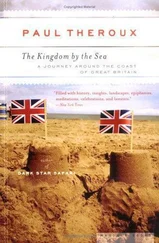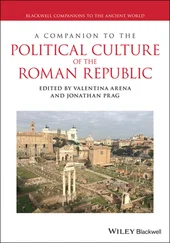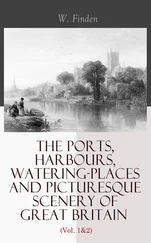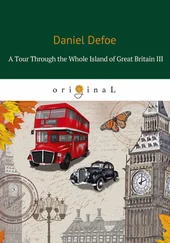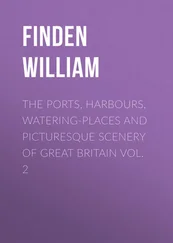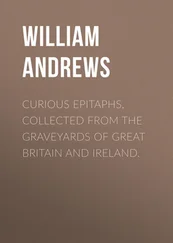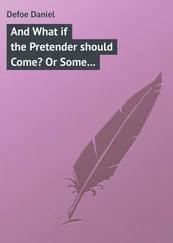
The national flower of Scotland is the thistle, a prickly-leaved purple flower which was first used in the 15th century as a symbol of defense. According to the legend it saved the country from enemies. Once a boat with Scandinavian Vikings landed on the Scottish shore in order to rob Celtic villages. A group of Scottish soldiers moved to meet the enemy on their way to the village and in the evening the Scots decided to spend night in the field because they didn’t expect Vikings attack at night. But cunning enemies wanted to kill all Scotts when they were sleeping, so Vikings walked barefoot to move quiet. But one of them stepped on a thistle and shouted with pain. It awoke the Scotts and they could fight with Vikings. Since then it became a symbol of Scotland. It is used as an amulet of good luck.
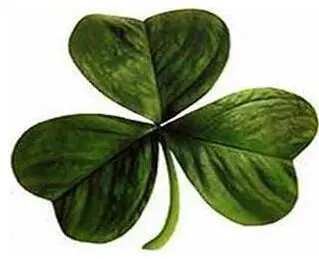
The national flower of Northern Ireland is the shamrock, a three-leaved plant similar to clover. An Irish tale tells of how Patrick used the three-leafed shamrock to explain the Trinity. He used it in his sermons to represent how the Father, the Son, and the Holy Spirit could all exist as separate elements of the same entity. His followers adopted the custom of wearing a shamrock on his feast day.
Exercise 1Can you answer these questions?
1) What is the official name of Britain?
2) Which are the biggest and the smallest countries of the UK?
3) What animals are represented on the national Coat of Arms?
4) What is the name of the national flag?
5) What saints patronize each country of the UK?
6) What are the national plant symbols of each country of the UK?
7) Who is the head of the state?
8) What is the national currency unit in Great Britain?
Exercise 2Test yourself: choose the most suitable answer.
1 A patron Saint of England is…:
a) St George;
b) St Patrick;
c) St David;
d) St Andrew.
2 A symbolic plant of Wales is…:
a) A red rose;
b) Leek / a daffodil;
c) Thistle;
d) Shamrock.
3 Who is the current monarch?
a) King George;
b) Queen Elizabeth II;
c) Queen Elizabeth I;
d) Queen Elizabeth III;
4 What country is not presented on the National Coat of Arms?
a) Scotland;
b) Northern Ireland;
c) Wales;
d) England.
5 What is the national currency of the UK?
a) The euro;
b) The dollar;
c) The pound;
d) The ruble.
6 What animal is presented on the National Coat of Arms?
a) A dog;
b) A snake;
c) A Horse;
d) A Unicorn.
7 What is the national motto of the UK?
a) Be strong;
b) God and my right;
c) In God we trust;
d) God save the Queen.
8 What country is called Eire?
a) The republic of Ireland;
b) Northern Ireland;
c) Wales;
d) England.
9 When is St David’s Day usually celebrated?
a) March 1;
b) November 30;
c) March 17;
d) April 23.
10 What is the English flag called?
a) Union Patrick;
b) Union Jack;
c) Lines and Crosses;
d) Uncle Sam.
Exercise 3Complete the table 2 with necessary information.
Table 2 – Symbols of Identity
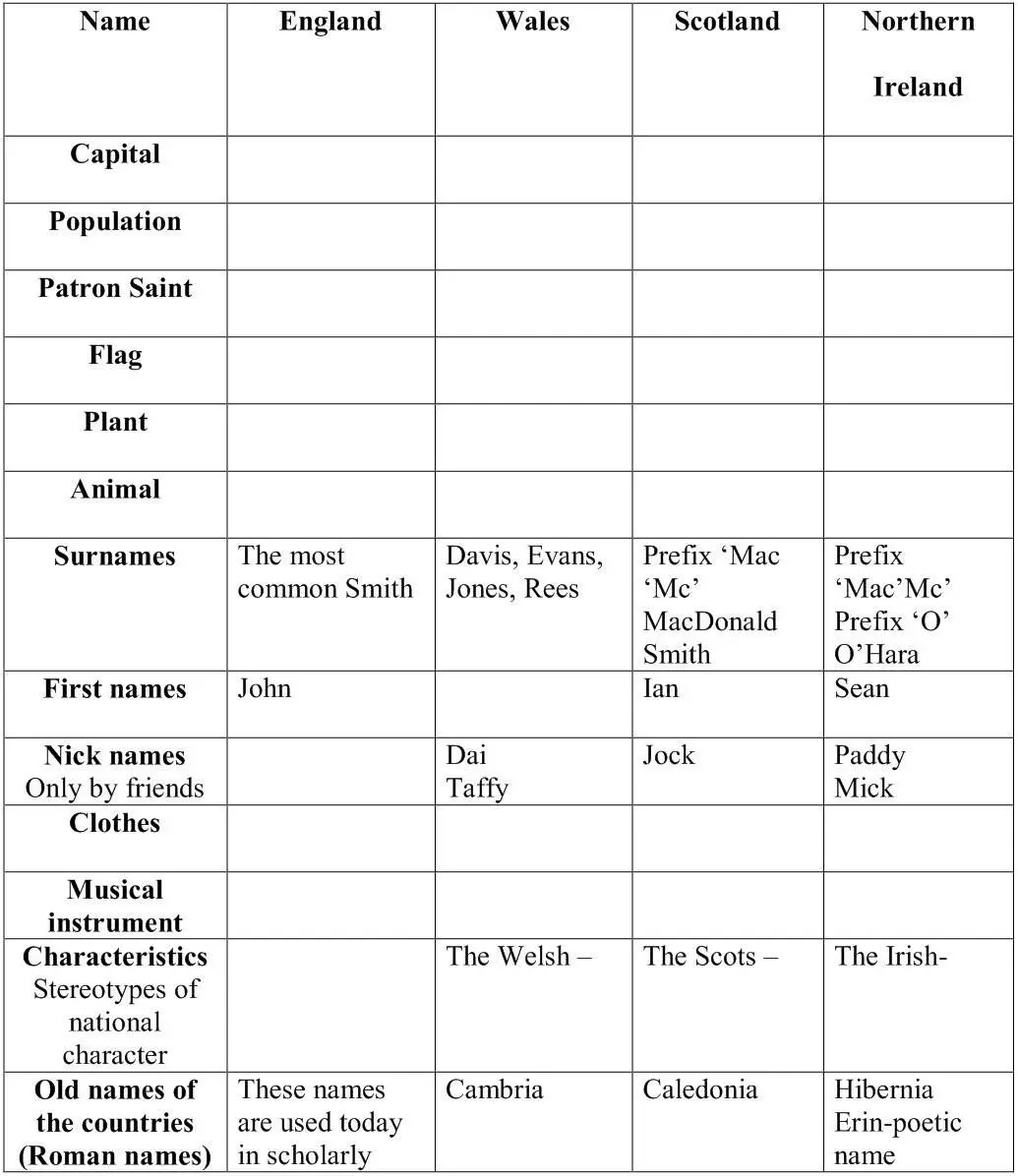

Did you know?
– There are over 30,000 John Smiths in Britain.
– After the 1745 rebellion, led by Bonnie Prince Charlie, the government made it illegal for Scotsmen to wear kilts. The ban remained in force until 1832.
– English (official) and Gaelic are the main languages of Scotland.
– The official animal of Scotland is Unicorn.
– The motto of Scotland is ‘No one provokes me with impunity’.
– Scottish surnames are divided in two main categories, namely Gaelic names and Germanic names.
– The official languages of Ireland are Irish and English.
– The most popular purchases made by tourists in Ireland are blackthorn walking sticks, Guinness glasses, Waterford Crystal and Aran Isle sweaters.
– The Welsh are the direct descendants of the Roman-era inhabitants of England and Wales, who were displaced and confined to the hilly and rocky western fringe of Britain by the Anglo-Saxons in the 5th and 6th centuries. The English name for Wales originates from the Germanic word Walha, meaning stranger or foreigner, which is related to the word Gaul. The French and Italian word for "Wales" is Galles, while the Spanish is Gales.
– Welsh, a Brythonic Celtic language, is ancestral tongue of Welsh people. Nowadays 750,000 people claiming a self-reported competence in Welsh (21,7 % of the population of Wales).
2 History of Britain: from Early Britain to the Middle Ages
About three thousand years В.C. many parts of Europe including the British Isles, were inhabited by a people called the Iberians. The Iberians used stone weapons and tools. They could polish stone and make smooth objects of stone.
In some parts of modern Britain one can see a number of huge stones standing in a circle. These are the monuments left by the earliest inhabitants of the country. The best-known stone-circle named Stonehenge dates from between 1900 and 1600 В. C. The stones are 8.5 metres high and weigh about 7 tons.
No one can tell how these large stones were moved, or from what places they were brought. Stonehenge is still a mystery to scientists.
There are a lot of legends connected with the Stonehenge. Some believed that the early British kings, killed by their enemies, were buried here; others think that Druids made it to house their pagan rites. Some say it was used for sun worship. It may have been a Temple for some form of worship – or a Court of Justice – or a Hall for ceremonial meetings of tribal chiefs.
2.2 Early Britain. The Celtic Tribes
During the period from the 6 thto the 3 rdcentury В. C. a people called the Celts spread across Europe from the east to the west. Some Celtic tribes – the Iberians, the Picts, the Scots and the Britons –invaded Britain. The Picts penetrated into the mountains on the North; the Scots settled in the North beside the Picts. Powerful Celtic tribes, the Britons, held most of the country, and the southern half of the island was named Britain after them. The Iberians were unable to fight back the attacks of the Celts and were driven westwards into the mountains what is now Wales.
The Greeks were the first to mention the British Isles. They wrote about the Phoenicians, great sailors and traders, who used to come to the British Isles for tin. They called the British Isles the Tin Islands.
Julius Caesar described the country and its inhabitants in his ‘Commentaries on the Gallic War’. He tells us that the Celts were tall and blue-eyed. They wore long moustaches but no beards.
In the 1 stcentury В. C. they lived in tribes, and were ruled by chiefs, or kings, whom all the tribesmen obeyed. In war-time the Celts wore skins and painted their faces with a blue dye to look fierce. They were armed with swords and spears. The Celts fought fiercely in the battle.
2.3 The Roman Conquest of Britain
Читать дальше





